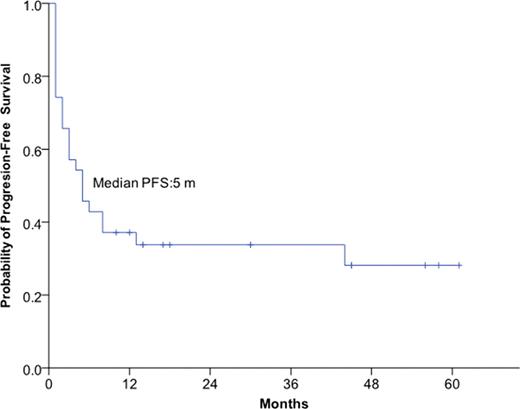Abstract
Abstract 1609
Salvage chemotherapy followed by autologous stem cell transplant (ASCT) remains to be the standard treatment for most patients with relapsed and refractory aggressive non- Hodgkin lymphoma(NHL) and Hodgkin lymphoma(HL). However, there are no standard salvage chemotherapy regimens for these patients especially for refractory patients. The combination of gemcitabine, vinorelbine and liposomal-doxorubicin (GVD regimen) had been reported to be effective in patients with relapsed HL (N.L.Bartlett et al. Ann Oncol. 2007).The overall response rate was 70% and the complete remission rate was 19%. The main toxicities were mucositis (23%) and febrile neutropenia (9%). Despite this encouraging result in relapsed HL, it was still unclear whether GVD regimen was effective in recurrent aggressive NHL.
This study aimed to evaluate the efficacy and toxicity of GVD regimen in patients with refractory aggressive NHL and HL.
Patients with aggressive NHL and HL who were relapsed or refractory to at least one salvage chemotherapy regimen were enrolled. The GVD regimen was given as follows: gemcitabine: 1000 mg/m2 intravenous(i.v.)on day 1,vinorelbine: 15 mg/m2 i.v. on day 1≤⪢liposomal-doxorubicin: 25 mg/m2 i.v. on day 1, repeated for 14 days≤®Patients with complete response (CR)or partial response (PR) proceeded to autologous stem cell transplant (ASCT) as consolidation.
From 1 May 2006 to 30 August 2008, 35 patients (25 NHL and 10 HL) were enrolled and received 129 cycles of chemotherapy. Twenty patients (57.1%) had been treated with at least 3 chemotherapy regimens before enrollment, and 15 patients (42.9%) had been treated with 2 chemotherapy regimens before. The overall response rate (ORR)was 48.6%(95% CI: 32.0%∼65.1%), with 31.4% CR rate(95%CI: 16.0%∼46.8%)≤®The ORR was higher in patients with HL than in patients with NHL(80.0% vs. 36.0%,p=0.023). The ORR was higher in relapsed patients than in refractory patients(73.3% vs. 30.0%,p=0.013). Sixteen patients (9 NHL and 7 HL) were treated by high dose chemotherapy supported by ASCT. With median follow-up of 16 months (2∼61 months),the median progression free survival(PFS) was 5 months(1∼61 months) and the median survival time was 38 months (2∼61 months). 4-year PFS and 4-year overall survival was 28.1% and 58.2% respectively. The serum LDH level and the sequential ASCT were independent prognostic factors. The survival time in patients treated with subsequent ASCT was significantly longer than those without ASCT (median survival: not reached vs. 21 months, p=0.005). The major toxicity was myelosuppression. The incidence of grade ¢ó/¢ô neutropenia and thrombocytopenia was 34.3% and 5.7% respectively≤®Mobilization of hematopoietic progenitor cell was successful in all the 16 patients. There were no treatment-related deaths.
GVD regimen is an effective and well-tolerated salvage regimen both for patients with HL and patients with aggressive NHL. GVD followed by AHST yields promising long-lime survival even in patients who are previously heavily treated.
No relevant conflicts of interest to declare.
Author notes
Asterisk with author names denotes non-ASH members.



